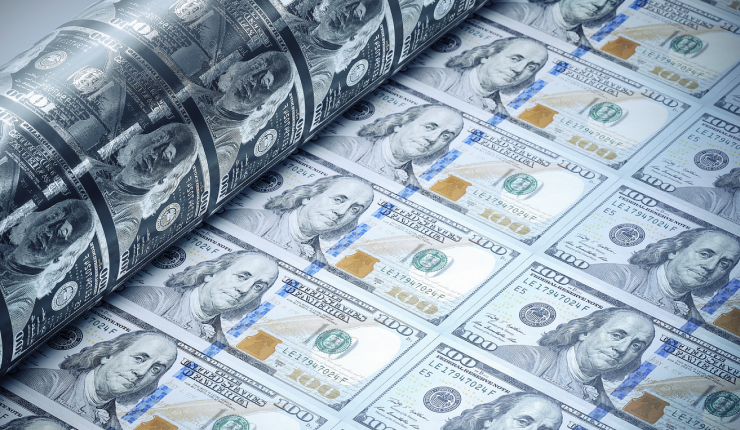Publication date
Share this article
What trajectory will the dollar follow in 2024? To find out, let’s examine the principal risk factors likely to influence the currency market over the coming months, our analysts’ forecast and the key dates to watch.
The main risk factors in 2024
A more dangerous and uncertain world
2024 is the year of localised geopolitical risk. Everything began on 7 October 2023 in the Middle East. Since then, the number of friction points has grown: China/Taiwan, China/Philippines, Iran/Pakistan, Russia/Ukraine, Venezuela/Guyana, and others.
Added to this is an intense electoral cycle. More than 40% of world GDP could change hands at elections:
- The US election on 5 November is a key focus of attention. Its outcome could prove a turning point in the war in Ukraine, for example. But this is not the only important election.
- Municipal elections in Turkey on 31 March will probably be won by the ruling AKP party in Istanbul and Ankara.
- Legislative elections in India in April/May are expected to result in a crushing victory for the party of outgoing Prime Minister Narendra Modi.
- Do not forget European elections and the general election in the UK in the second half of the year, which is likely to see the Labour party return to power.
- Lastly, early legislative elections are probable in Israel, leading to the possible departure of Prime Minister Benyamin Netanyahu – a potential turning point in the conflict.
The world at the end of 2024 will be nothing like the world we know today.
Canals in danger
For decades, it was thought that trading routes were secure, but this no longer holds true. The strait at the entry of the Red Sea, through which 21% of global container trade transits, is not safe to navigate today because of the asymmetric war pitting the Iran-backed Houthi rebels against an international coalition including France. Ships are having to be re-routed through the Cape of Good Hope in South Africa, raising freight costs. But this is not sufficient to rekindle inflation. A report published in January by the Bank of England showed that if the Red Sea route is disrupted throughout 2023, this would only raise annual inflation by a meagre 0.4-0.6 points. That said, it would lead to congestion at ports, as was the case during the Covid crisis, destabilising supply chains, particularly in Europe.
Asia is no longer safe either. Shipping routes in Eastern Asia that cross the Taiwan strait and the South China sea, through which 40% of the EU’s external trade transits, could become more dangerous amid mounting tensions between China and neighbouring countries (Taiwan and the Philippines) over the sovereignty of several islands and atolls. Climate change is another factor to consider.
The Panama Canal is no longer fully operational because of an unprecedented drought.
The safe passage of goods is becoming a structural subject for the markets and the economy. This is new.
A different monetary cycle from others
Policy rates are set to be lowered in 2024. This is the only certainty. But when and by how much? This is where the difficulty lies.
There is big disconnect between market expectations and what central bankers are saying. The money market forecasts around 150-160 basis points of rate cuts on both sides of the Atlantic this year.
Central bankers are more sceptical. Their baseline scenario is 50-75 basis points of rate cuts.
This is a differential of almost 100 basis points. One of the two is wrong. We think it is the money market, which is forecasting an aggressive rate-cutting cycle like those seen in the past. But there is one major difference this time: there is no recession.
Consequently, it does not make sense to slash interest rates. This is the message central banks are conveying. This cycle is different. It will take a little time before the markets revise down their expectations.
At the very least, this implies a revival of volatility in the currency market.
We have not heard the last from the dollar
There is unanimous agreement that the dollar will fall this year. All analysts and investment banks have conveyed this message since the end of 2023. We disagree. All the arguments put forward to justify a depreciation of the dollar are disproven by the facts.
Reason No.1: the European economy will outperform the US. Kerplunk! This is not what we foresee. Eurozone growth is likely to reach 0.5% this year in the best-case scenario. Downside risks are considerable, mainly because of the German recession and France’s lacklustre growth. In contrast, the US economy is showing impressive resilience. We forecast growth of close to 1.5%. Even if the US economy experiences zero growth over all four quarters of 2024, which is highly unlikely, the growth carryover is already 1.2%! This is enormous. It implies that the US economy will outperform the eurozone, reinforcing inflows into the US. This is a structural support factor for the US dollar.
Reason No.2: dedollarisation. This has been a well-worn monetary mantra since the 1970s and the first oil shock. Two figures: 85% of oil transactions are made in dollars, as are 88% of international transactions. The dollar has its drawbacks. But there is no alternative (certainly not the Chinese yuan). It is the most liquid currency in existence. The entire financial system is anchored on the dollar and the historical system of US geopolitical alliances creates powerful network effects and reinforces the dollar’s hegemony as a means of exchange, a supplier of liquidity and an international reserve currency. The dollar is inescapable. Dedollarisation is a nice story, but the facts do not support it.
Reason No.3: declining productivity. This is the most fallacious argument. The problem is that productivity is no longer falling in the US. It has actually increased significantly over recent quarters! At the end of 2023, productivity gains reached +3.2%. In contrast, they are negative in the eurozone.
Reason No.4: rate cuts by the US Federal Reserve (Fed). Yes, interest rates are set to fall. This is not in doubt. But we think this process will start later and take longer than the consensus forecasts. Analysts are wrong in thinking the central bank will slash the cost of money, as in past cycles. Two factors are missing: there is no recession in sight over the next 12 months and, most importantly, inflation is still too high for the Fed to lower its guard (in particular inflation in services and wage increases). This economic cycle is different. It requires an appropriate monetary response.
To sum up, like last year, the market environment will probably continue to be marked by the strong dollar. It is the dollar zone that will continue to capture the lion’s share of capital and financial flows.
Key dates to watch
08/02: The US Supreme Court will examine if US states can disqualify Donald Trump from the presidential election because of his attempts to reverse the result of the 2020 elections and his role in the insurrection of 6 January. This is only the start of the former US president’s legal proceedings.
16-18/02: Munich Security Conference. This is normally a non-event. But against the backdrop of the war in Ukraine, this conference is of particular importance this year.
24/02: Second anniversary of Russia’s invasion of Ukraine. This is an endless conflict. This year alone, Ukraine has to send 500,000 more men to the war front. This is unsustainable.
Late-February/March: NATO is due to hold its biggest military exercise since the cold war. The Steadfast Defender – Europe 24 operation will bring together 30 countries and 40,000 soldiers. The exercise will take place in Germany, Poland and Baltic countries and will concentrate on preparations and interoperability in response to a possible Russian invasion.
05/03: Super Tuesday. This term appeared for the first time in 1988. It refers to the first Tuesday in March when a large number of states simultaneously hold their caucus and primary elections for the two dominant American parties. This year, the election will be held in some heavyweight states, such as California and Texas.
15-18/07: Republican Party Convention to anoint the presidential candidate.
19-22/08: Democratic Party Convention.
05/11: US presidential election. If he wins, Donald Trump plans to eliminate within four years Chinese imports of electronic goods, steel and pharmaceutical products. This runs the risk of intensifying the trade war. But make no mistake about it: a second term for Joe Biden does not imply an easing of tensions. Between Biden and Trump, it is mainly the form, not the substance, that differs when it comes to China. Both want to reduce the US economy’s dependence on China.
Topics






